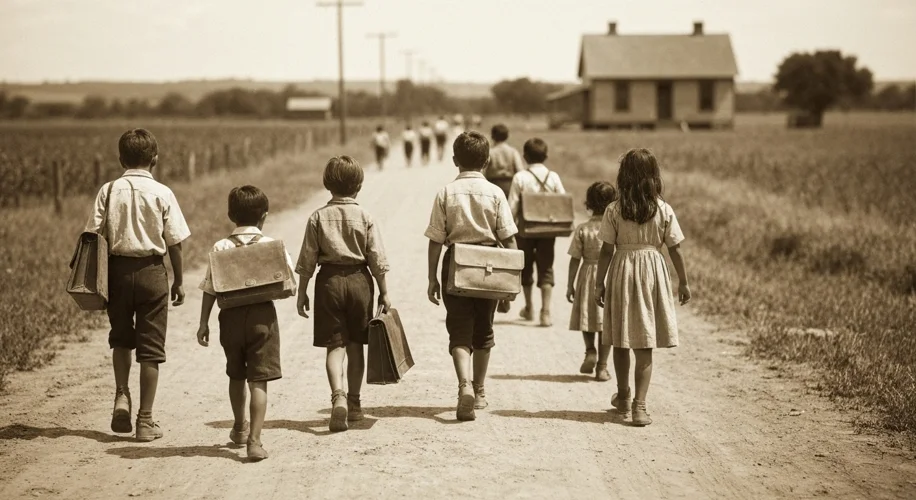The morning bus stop. For many, it’s a mundane, everyday scene – children bundled against the crisp air, the rumble of an approaching engine, the familiar yellow behemoth arriving to ferry them to learning. But this seemingly simple act of getting to school has a long, complex, and often inequitable history, deeply intertwined with access to education itself. Today, we often take for granted the buses that traverse our communities, but their evolution is a story of progress, struggle, and the ongoing quest for educational fairness.
In the early days of public education in America, the concept of universal access was far from realized. As towns and cities grew, so did the need for organized schooling. However, reaching these nascent schools was a significant hurdle, particularly for rural communities. Children often walked miles, sometimes through difficult terrain and inclement weather, just to attend. This naturally favored those living closer to the schoolhouse, creating an immediate geographical barrier to education. Those who couldn’t walk, or whose families couldn’t afford alternative transportation, were effectively excluded.

As the 19th century progressed and the idea of centralized, graded schools took hold, the challenge of distance became more pronounced. The development of horse-drawn omnibuses and later, the electric streetcar in urban areas, began to offer solutions. However, these were often privately operated and costly, making them inaccessible to many working-class families. The vision of a truly public education was still hampered by the very real logistics of getting students to the classroom.
The real revolution in school transportation, however, arrived with the automobile and the dedicated school bus. The early 20th century saw a burgeoning realization that if education was to be a right for all, then the means to access it must also be provided. Rural school consolidation, a movement to close smaller, less-resourced schools in favor of larger, more comprehensive ones, made consolidated transportation not just a convenience, but a necessity.
The introduction of the standardized yellow school bus in the 1930s, largely credited to Dr. Frank E. Cyr, a professor at Columbia University Teachers College, marked a turning point. Cyr, recognizing the diversity of vehicles used and the need for safety and uniformity, traveled the country studying various designs. He advocated for specific features like a higher chassis, higher seat backs, and, crucially, the distinctive yellow color – chosen for its visibility in all weather conditions. This standardization was a monumental step towards ensuring that all children, regardless of their location, could arrive at school safely and reliably.
However, the history of school transportation is not merely about the vehicles; it’s profoundly linked to the struggle for desegregation and civil rights. For decades, segregated schools meant segregated transportation. Black children, often attending underfunded and distant schools, faced arduous journeys. The landmark Supreme Court decision in Brown v. Board of Education in 1954 declared state-sponsored segregation in public schools unconstitutional. The subsequent implementation of desegregation plans, particularly in the South, often involved busing students to achieve racial balance.
This busing, while a powerful tool for dismantling segregation and promoting equity, was also incredibly controversial. It led to significant social upheaval, protests, and deeply entrenched opposition from those resistant to integration. Families on all sides of the racial divide expressed concerns about the length of bus rides, the safety of students in unfamiliar neighborhoods, and the perceived imposition on parental choice. The famous image of a school bus becoming a focal point for protest, shuttling children through tense, divided communities, underscores the complex social and political dimensions of school transportation.

Beyond desegregation, the issue of transportation equity has continued to surface in debates about school funding and resource allocation. In many districts, the quality and availability of school transportation can still reflect socio-economic disparities. Students in wealthier districts might benefit from newer buses, more frequent routes, and shorter travel times, while those in lower-income areas may face older fleets, longer rides, and fewer options.
The digital age has introduced new considerations, with discussions around the efficiency of bus routing, the environmental impact of bus fleets, and the potential for technology to enhance safety and communication. Yet, the fundamental principle remains: how do we ensure that every child has a reliable and equitable means to access the education they deserve?
From the solitary walk along a dusty road to the controversial busing of the civil rights era, the journey to school has been a constant reflection of our society’s commitment to educational equity. The yellow school bus, in its familiar hue, carries not just students, but the weight of this history – a history of striving for a future where the path to knowledge is open to all, unhindered by the distance or the circumstances of birth.

